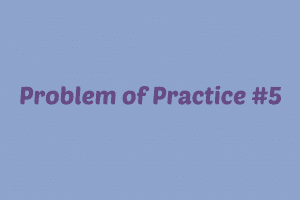CBE Problems of Practice: Granularity on Advance Upon Mastery is Too Small
CompetencyWorks Blog
 This is the fifth in a series on problems of practice. (Check out the articles on grading, attendance, pace, and individualized learning.) We are interested in hearing from readers about other problems of practice they’ve seen or are struggling with in implementation.
This is the fifth in a series on problems of practice. (Check out the articles on grading, attendance, pace, and individualized learning.) We are interested in hearing from readers about other problems of practice they’ve seen or are struggling with in implementation.
5. Demanding that students demonstrate achievement on every small standard. We’ve heard of situations in which schools are holding students back from more advanced studies due to not learning very small and inconsequential skills or knowledge. Parents are legitimately asking about the value of some learning standards that were designed with coverage in mind, but are now being used for student level accountability in a competency-based system. In traditional schools we primarily looked for memorization and comprehension based on either state standards or what the teacher covered in lecture or textbooks. In competency-based schools we look for something else. We want students to be able to use content knowlege as they solve problems. We want them to develop a higher set of skills and be able to fully engage in the key concepts and facts within each domain. You could think of this as the difference between standards-based and competency-based.
If students are having a difficult time learning either knowledge or skills, it might be the right thing to let them work longer on it and not push them forward to the next set of learning targets. However, it might also be the right thing to let them advance while returning to or creating opportunities to continue to strengthen those areas that they haven’t mastered. This requires teacher judgment about what will be best for students based on a number of criteria.
The problem of holding students back based on bite-size standards seems to happen when aspects of competency-based education are implemented in a bureaucratic fashion rather than taking the step back to think about what we want students to learn and do, how to best help them to learn it, and then asking how we will be confident that they really learned it. It’s important to keep returning to what the science of learning tells us — some learning occurs over time and requires students returning to it repeatedly. Thus, advance upon mastery isn’t applied to every standard. Instead, it’s a question of how do we make sure students have the skills and knowledge they need to be successful.
The introduction of larger graduation competencies helps to keep the focus on what we want students to know and be able to do when they graduate. Thus, teachers can determine the value of skills and knowledge within the context of what is important to students.
Furthermore, students should not be held back or retained if they aren’t proficient. Simply covering the content a second time isn’t going to help if they have specific gaps in knowledge. The key is to ensure that there is a plan, even one that includes the teacher in the spring and the teacher in the fall, to provide adequate instructional support for students to keep learning, growing, and progressing toward higher performance levels. Scaffolding up to help students access more challenge coursework and scaffolding down to make sure gaps in knowledge and skills are being repaired are both needed.
Getting Implementation Right: Districts and schools need to ensure that they have a moderated (i.e. consistent) understanding of the competencies at the different performance or grade levels. Systems should be in place to help teachers determine what students know and can do (and where there are gaps) so that this information can be taken into consideration when grouping and so that additional support can be offered immediately rather than waiting for students to fail.
Keep a look out for rigid rule-based decisions rather than making them around the student and scaffolding that only allows students to access curriculum. Celebrate teachers and students when gaps are filled!
Read the Entire Series:
- Introduction – What Not To Do: Six Problematic Practices in the Transition to Competency Education
- Part 1 – Missteps in Implementing Competency Education: Introducing Grading Too Early
- Part 2 – CBE Problems of Practice: Attendance Requirements
- Part 3 – CBE Problems of Practice: Self-Pace and Faster is Better
- Part 4 – CBE Problems of Practice: Individualizing Learning
- Part 5 – CBE Problems of Practice: Granularity on Advance Upon Mastery is Too Small
- Part 6 – CBE Problems of Practice: Late Work
- Part 7 – What to Do When the Field Goes “Mustard”